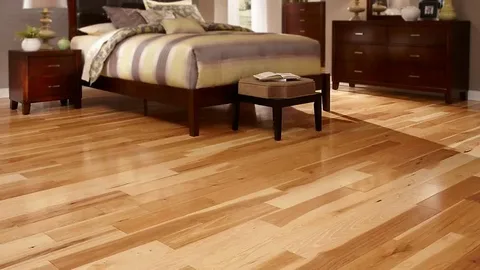When choosing the right flooring for your home, two popular options that often come up are engineered wood and solid wood flooring. Both types of flooring offer distinct advantages and considerations, which can affect your decision based on factors like durability, appearance, cost, and installation process. Understanding the differences between engineered wood and solid wood is crucial for selecting the best flooring material that aligns with your needs and budget.
In this article, we’ll explore the key differences between engineered wood and solid wood flooring, breaking down their features, pros and cons, and which one might be best suited for your living space.
What Is Engineered Wood Flooring?
Engineered wood flooring is a type of flooring made from multiple layers of real wood veneers, bonded together under heat and pressure. The top layer, or veneer, is typically a hardwood, such as oak, maple, or hickory, giving the floor the appearance of solid wood. Beneath this veneer are several layers of plywood or high-density fiberboard (HDF) that create a stable core. The construction of engineered wood allows it to expand and contract with changes in humidity, making it more adaptable to fluctuating environments.
Key Features of Engineered Wood Flooring:
- Multiple Layers: The multiple layers of engineered wood flooring are designed to improve stability, reduce expansion and contraction, and prevent warping.
- Variety of Wood Types: Like solid wood, engineered wood can be crafted from a variety of hardwoods, providing a diverse range of finishes and styles.
- Installation Flexibility: Engineered wood can often be installed as a floating floor, glued down, or nailed down, offering versatility depending on the space and subfloor type.
- Eco-Friendly Option: Since the core layer is made from plywood or other engineered materials, the use of solid hardwood is minimized, making engineered wood a more environmentally friendly option than solid wood.
What Is Solid Wood Flooring?
Solid wood flooring, as the name implies, is made from a single piece of natural wood. The boards are typically milled from a variety of hardwood species like oak, cherry, maple, or walnut. These boards are cut from a single piece of timber, giving the floor a continuous and uniform look. Solid wood flooring has been a staple in home flooring for centuries due to its timeless beauty and natural durability.
Key Features of Solid Wood Flooring:
- Single Layer Construction: Solid wood flooring is made from one continuous piece of wood, offering a consistent appearance and texture across the entire floor.
- Natural Beauty: Solid wood offers unique grain patterns and colors that enhance its aesthetic appeal and can increase in value over time.
- Longevity: Properly maintained solid wood flooring can last for generations, making it an investment that adds lasting value to a home.
- Refinishing Ability: One of the major advantages of solid wood flooring is the ability to sand and refinish it multiple times, restoring the surface and removing wear and tear marks over time.
Key Differences Between Engineered Wood and Solid Wood Flooring
The most obvious difference between the two flooring types is their construction. Engineered wood consists of multiple layers, with the top layer being a veneer of real wood. In contrast, solid wood flooring is made from a single piece of solid hardwood. This makes solid wood a more natural and traditional option, while engineered wood benefits from a more modern and stable design.
Durability and Stability
Engineered wood flooring tends to be more stable in environments where temperature and humidity fluctuate. This is due to the cross-layer construction, which minimizes the risk of warping, cupping, or expanding. Engineered wood can be a better choice for areas such as basements or above radiant heating systems, where solid wood might face challenges.
Solid wood flooring, while extremely durable and long-lasting, is more sensitive to environmental changes. Solid wood tends to expand and contract with changes in humidity, which can lead to gaps or warping if not properly maintained or installed in the right environment. However, it can be refinished several times, restoring its beauty and correcting imperfections.
Appearance
Both engineered wood and solid wood flooring have the same appearance when it comes to the top veneer layer. The grain patterns, colors, and textures of both types of wood can be very similar. However, because engineered wood has a thinner veneer layer, its aesthetic qualities may not be as deep or rich as solid wood, which features a more substantial and continuous wood grain. The difference in visual appeal may be subtle, but for those looking for the authentic look of hardwood, solid wood might be more appealing.
Installation
Engineered wood flooring is generally easier to install compared to solid wood. It can be installed using a floating method, where the planks click together without being glued or nailed to the subfloor. This makes the installation process faster and more accessible for DIY projects. Additionally, engineered wood can be installed over various types of subfloors, including concrete, plywood, or even existing floors.
Solid wood flooring typically requires more skill and precision for installation. It must be nailed or glued to a subfloor, and it often needs a dry, clean environment. Solid wood also requires more time for acclimation before installation to ensure the wood adjusts to the room’s temperature and humidity.
Cost
When it comes to cost, solid wood flooring is generally more expensive than engineered wood. The price of solid wood is driven by the quality of the wood, which can vary significantly depending on the species and finish. Additionally, installation costs for solid wood may be higher due to its more complex installation process.
On the other hand, engineered wood is typically more affordable, as the production process uses a combination of materials, making it less expensive to produce. This makes engineered wood a more cost-effective option, particularly for large spaces or those on a budget.
Maintenance
Both types of flooring require similar maintenance in terms of cleaning and occasional care. However, solid wood flooring might require more frequent refinishing over time to maintain its original look, especially if the finish has worn down or the boards have been scratched.
Engineered wood is often easier to maintain, especially if it is prefinished. Since it doesn’t have to be refinished as often as solid wood, its maintenance can be simpler. However, if the veneer layer is damaged, it cannot be sanded down and refinished like solid wood can.
Environmental Impact
Engineered wood is often considered a more environmentally friendly option compared to solid wood because it uses less hardwood in its construction. The core layers are typically made from more sustainable materials like plywood, which reduces the demand for rare and expensive hardwood species.
Solid wood flooring, while made from natural materials, requires the harvesting of whole trees, which can contribute to deforestation if not responsibly sourced. For those concerned with environmental impact, looking for FSC (Forest Stewardship Council)-certified solid wood options can help ensure sustainability.
Conclusion
Choosing between engineered wood and solid wood flooring depends on your specific needs, preferences, and the environment of the space you are upgrading. If you are looking for a more stable, budget-friendly option that can be installed easily, engineered wood might be the best choice. On the other hand, if you prioritize long-term durability, the ability to refinish, and a traditional aesthetic, solid wood flooring is an excellent investment.
Both types of wood flooring offer timeless beauty and lasting appeal, and either can elevate the style and comfort of your home. Be sure to consider factors like installation, maintenance, environmental conditions, and cost when making your final decision.
FAQs:
Q1: Can engineered wood be refinished?
A1: Engineered wood can be refinished, but only if the veneer layer is thick enough. However, it can only be refinished once or twice, unlike solid wood, which can be sanded and refinished multiple times.
Q2: Is engineered wood better for high-humidity areas?
A2: Yes, engineered wood is better suited for high-humidity areas like basements, as it is less likely to warp or buckle due to moisture. Solid wood can be more vulnerable to these changes in environment.
Q3: Which option is more durable?
A3: Solid wood is generally more durable over time because of its thickness and ability to be refinished. However, engineered wood can still last for many years, especially in stable environments, and is less prone to expansion and contraction.
Q4: Does engineered wood look as good as solid wood?
A4: Yes, engineered wood can look just as good as solid wood. The top veneer layer is made from real hardwood, so the appearance is nearly identical to solid wood. The difference lies in the overall depth and texture, with solid wood offering a more continuous grain pattern.
Q5: How much does installation cost for each?
A5: Installation costs for solid wood are typically higher due to the more complex nailing or gluing process. Engineered wood tends to have lower installation costs, especially if using a floating floor method.

